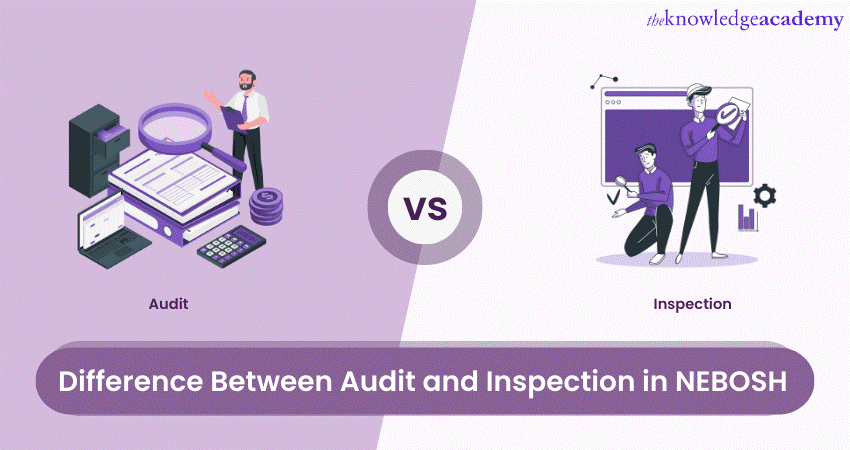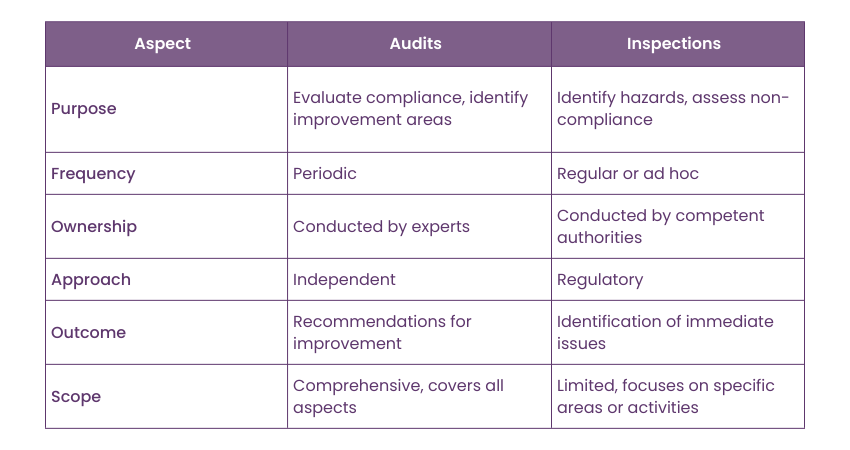We may not have the course you’re looking for. If you enquire or give us a call on +800 312616 and speak to our training experts, we may still be able to help with your training requirements.
Training Outcomes Within Your Budget!
We ensure quality, budget-alignment, and timely delivery by our expert instructors.

The National Examination Board in Occupational Safety and Health (NEBOSH) is well known for its comprehensive qualifications and is vital in promoting secure work environments. Two standard practices in securing a safe environment include the Inspecting and Auditing process. Understanding the Difference Between Audit and Inspection in NEBOSH is crucial for workplace safety and compliance.
Do you wish to explore the purposes, focuses, scopes, approaches, outcomes, and examples of audits and inspections? If so, keep reading this blog. By highlighting their unique contributions, we provide insights for professionals and organisations seeking to establish robust safety practices in NEBOSH. This blog will highlight the Difference Between Audit and Inspection in NEBOSH and give you an overview of each practice.
Table of Contents
1) Understanding audit
2) Exploring inspection
3) Key Difference Between Audit and Inspection in NEBOSH
a) Frequency
b) Ownership
c) Approach
d) Outcome
e) Scope
4) Conclusion
Understanding audit
An audit is integral to health and safety management systems, ensuring Compliance and driving improvement. It evaluates adherence to regulations and identifies areas for enhancement. Conducted by experts, this process provides comprehensive reviews of processes and records, offering valuable recommendations for improving safety performance.
Purpose and focus
The primary purpose of an audit is to evaluate compliance and identify areas for improvement in health and safety management. It involves a systematic review of processes and records, focusing on their effectiveness and alignment with safety standards. Audits cover all aspects of an organisation, from policies and procedures to operational practices.
Keen on starting a career in Nebosh, refer to our blog on "Nebosh National Diploma vs International Diploma"
Examples and recommendations
Audits encompass various types, including internal and financial types. Internal audits assess internal processes, while financial one evaluates financial controls. Expert auditors provide recommendations for improvement, guiding organisations towards enhanced safety performance. This process allows organisations to gain valuable insights to strengthen their health and safety practices and ensure compliance with regulations.
Exploring inspection
Inspection plays a vital role in identifying hazards and non-compliance in health and safety. It involves physically examining equipment, systems, and workplaces. These practices are more focused, targeting specific areas or activities, and are often conducted by competent authorities due to their regulatory nature.
Purpose and outcomes
Inspections include workplace investigations that assess specific work areas, equipment, and practices. Regulatory inspections conducted by government or regulatory bodies verify compliance with established safety standards. Due to their regulatory nature, inspections are crucial in upholding safety regulations and ensuring organisations meet required safety standards.
Strengthen your understanding on nebosh, refer our blog on "Difference between IOSH, Nebosh and Osha"
Examples and regulatory nature
Inspections include workplace investigations that assess specific work areas, equipment, and practices. Regulatory inspections conducted by government or regulatory bodies verify compliance with established safety standards. Due to their regulatory nature, inspections are crucial in upholding safety regulations and ensuring organisations meet required safety standards.
Try our NEBOSH HSE Certificate in Health and Safety Leadership Excellence Training today!
Key Difference Between Audit and Inspection in NEBOSH
In summary, audits and inspections have distinct roles in NEBOSH. Audits are focused on evaluating compliance and identifying areas for improvement within Health and Safety Management Systems in the Workplace. They systematically review processes and records to ensure adherence to regulations and drive continuous improvement.
On the other hand, inspections primarily aim to identify hazards and assess non-compliance in equipment, systems, and workplaces. They involve physical examinations and observations to verify specific areas or activities' safety and regulatory compliance. To facilitate a clearer understanding of the differences, let's refer to the following table:

Frequency
Audits are typically conducted periodically at predetermined intervals, ensuring ongoing compliance and continuous improvement. The frequency of how often this process takes place may vary depending on regulatory requirements, organisational policies, and NEBOSH risk assessments. On the other hand, inspections can occur regularly, such as routine safety investigations, or on an ad hoc basis, triggered by specific events or concerns. The frequency of this process may be determined by regulatory requirements, industry standards, or the organisation's internal protocols.
Interested to know the validityof your nebosh certification refer to our blog on "Nebosh Certificate validity"
Ownership
Audits are usually conducted by internal or external experts who possess the necessary knowledge, skills, and experience in health and safety management systems. These auditors often have specialised training and qualifications in auditing techniques, regulatory compliance, and industry-specific knowledge. On the other hand, inspections are typically carried out by competent authorities, such as government agencies, regulatory bodies, or authorised inspectors with the legal authority and expertise to enforce compliance with safety regulations.
Try our NEBOSH National General Certificate in Occupational Health and Safety Course!
Approach
Audits are independent and objective, providing an unbiased evaluation of an organisation's health and safety management system. Auditors review processes, procedures, documentation, and records to assess compliance with applicable regulations and internal standards.
They may conduct interviews, site visits, document reviews, and performance evaluations to gather evidence and make informed judgments. Inspections, in contrast, have a regulatory approach. They are designed to verify compliance with specific regulations, standards, or codes of practice. Inspectors primarily focus on identifying hazards, potential risks, and instances of non-compliance through physical investigations, observations, and assessments of equipment, workplaces, and practices.
Interested in clearing and knowing the exam pattern, refer to our blog on "Nebosh Open Book Examination"
Outcome
One of the key outcomes of audits is the generation of recommendations for improvement. Auditors provide detailed reports highlighting areas of non-compliance, potential risks, and opportunities for enhancing the organisation's health and safety performance. These recommendations guide organisations in implementing corrective actions, enhancing their safety management systems, and achieving regulatory compliance.
On the other hand, inspections primarily aim to identify immediate issues and instances of non-compliance. The outcomes of this process often include the issuance of notices, warnings, or citations for non-compliance. Inspectors may require immediate rectification of identified hazards or non-compliance to ensure the safety and well-being of workers and the public.
Scope
Audits have a comprehensive scope, covering all aspects of an organisation's operations related to health and safety. This includes reviewing policies, procedures, documentation, training programs, risk assessments, and incident investigations.
To learn more abou Nebosh audit and inspection refer our blog "Nebosh Question paper"
Conclusion
In conclusion, understanding the Difference Between Audits and Inspections in NEBOSH is crucial for maintaining workplace safety and compliance. Organisations can establish robust health and safety management systems by utilising both processes. NEBOSH qualifications play a vital role in promoting safe working environments and ensuring the competence of health and safety professionals. Organisations and professionals must embrace these practices to create a culture of safety and well-being.
Try NEBOSH International General Certificate in Occupational Health and Safety Training!
Frequently Asked Questions

An HSE audit is a comprehensive evaluation of safety systems, while an HSE inspection focuses on immediate risks and compliance with safety standards.

The 3 C’s of auditing refer to Communication, Culture, and Coordination, which are essential for successful internal auditing processes.

The Knowledge Academy takes global learning to new heights, offering over 30,000 online courses across 490+ locations in 220 countries. This expansive reach ensures accessibility and convenience for learners worldwide.
Alongside our diverse Online Course Catalogue, encompassing 17 major categories, we go the extra mile by providing a plethora of free educational Online Resources like News updates, Blogs, videos, webinars, and interview questions. Tailoring learning experiences further, professionals can maximise value with customisable Course Bundles of TKA.

The Knowledge Academy’s Knowledge Pass, a prepaid voucher, adds another layer of flexibility, allowing course bookings over a 12-month period. Join us on a journey where education knows no bounds.

The Knowledge Academy offers various NEBOSH Courses, including the NEBOSH Award In Health and Safety at Work Course, NEBOSH Working with Wellbeing Training and NEBOSH HSE Award in Managing Risks and Risk Assessment at Work Training. These courses cater to different skill levels, providing comprehensive insights into Importance of Safety at Workplace.
Our Health & Safety Blogs cover a range of topics related to health and safety, offering valuable resources, best practices, and industry insights. Whether you are a beginner or looking to advance your mitigate risk skills, The Knowledge Academy's diverse courses and informative blogs have got you covered.
Upcoming Health & Safety Resources Batches & Dates
Date
 NEBOSH National General Certificate in Occupational Health and Safety
NEBOSH National General Certificate in Occupational Health and Safety







 Top Rated Course
Top Rated Course



 If you wish to make any changes to your course, please
If you wish to make any changes to your course, please


